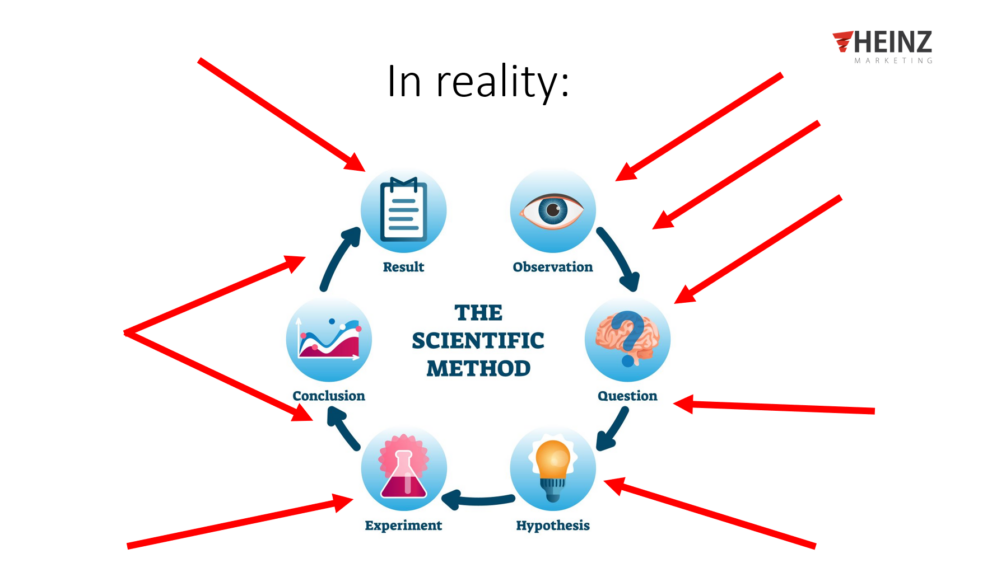Maximizing Business Success: 5 Strategic Methods for Collecting Valuable Insights

Summary
To form an effective strategy and stay competitive in today’s dynamic market landscape, one must have the ability to gather and leverage valuable insights that drive informed decision-making. In this blog post, learn about 5 sources you and your teams can use to harness valuable insights to build strategies with greater impact.
By Carly Bauer, Marketing Consultant at Heinz Marketing
To form an effective strategy and stay competitive in today’s dynamic market landscape, one must have the ability to gather and leverage valuable insights that drive informed decision-making.
Whether it’s for planning strategic company direction, departmental initiatives, or team-oriented goals, the significance of collecting relevant and impactful insights cannot be overstated. These insights serve as guiding beacons toward effective strategies that not only navigate the present but also paint a picture of the potential future.
In this blog post, learn about 5 sources you and your teams can use to harness valuable insights to build strategies with greater impact.
Market Research and Analysis
Market research and analysis form the foundation of informed decision-making for businesses. Understanding the nuances of industry trends, consumer behaviors, and competitor strategies is paramount for devising successful strategies that align with market demands.
Discover Current Industry Trends and Consumer Behaviors
Staying attuned to industry trends provides a window into the evolving landscape in which a business operates. Whether it’s technological advancements, shifts in consumer preferences, or regulatory changes, comprehending these trends allows companies to adapt their offerings proactively. Furthermore, deciphering consumer behaviors through research sheds light on what drives purchasing decisions, enabling businesses to tailor their products or services to meet customer needs effectively.
Methodologies for Gathering Insights Through Market Research
Companies employ various methodologies to extract valuable insights from their target audience.
- Surveys both online and offline, provide quantitative data and statistical insights into consumer preferences.
- Focus groups and interviews delve deeper into qualitative aspects, unveiling nuanced opinions and attitudes.
- Social media listening tools provide real-time feedback, tapping into the pulse of public sentiment.
Analyzing Market Reports and Reliable Data
The impact of analyzing market reports, industry publications, and data from reliable sources cannot be overstated. These sources offer comprehensive insights into market dynamics, competitive landscapes, and emerging opportunities. By using these resources, businesses can gain a clearer understanding of market gaps, potential threats posed by competitors, and unexplored avenues ripe for growth.
Market research and analysis empower businesses to make informed decisions by deciphering complex consumer behavior, industry trends, and competitor strategies. It serves as a compass to help guide strategic planning and facilitate a competitive edge in an ever-evolving market ecosystem.
Data Analytics and Metrics
The role of data analytics in shaping an effective strategy is very beneficial for collecting valuable insight. It serves as a pivotal tool in gathering and deciphering information crucial for informed decision-making within businesses of all sizes and industries.
Tracking and Analyzing Key Performance Indicators (KPIs)
Key Performance Indicators (KPIs) are vital metrics that offer a snapshot of a company’s performance in various areas. Whether it’s sales figures, customer acquisition costs, website traffic, or customer satisfaction rates, tracking these KPIs provides a clear understanding of where the business stands. Advanced tools and software dedicated to data analytics enable organizations to not only collect these metrics but also analyze trends and patterns over time. This helps provide an understanding of current performance and what to expect in the future based on past statistics.
Leveraging Business Intelligence Tools
Business Intelligence (BI) tools play a pivotal role in extracting actionable insights from sizeable datasets. These tools are designed to handle large and complex data sets, utilizing algorithms and analytical techniques to identify correlations, trends, and anomalies that might not be evident at first glance. By employing BI tools, businesses can uncover hidden patterns, understand customer behaviors, and forecast future trends, all of which are invaluable for effective strategy planning.
Through business intelligence, organizations can make data-driven decisions, gaining insights into customer preferences, market trends, and operational efficiencies. This empowers them to adapt quickly to changing market dynamics and make informed strategic choices, ultimately leading to a competitive edge in the marketplace.
Overall, data analytics and business intelligence tools are not just sources of information; they’re critical assets that enable businesses to transform raw data into actionable insights, driving effective strategy planning and informed decision-making processes.
Feedback from Stakeholders
Gathering feedback from a wide array of stakeholders is instrumental in shaping a robust strategic plan. Internal and external stakeholders, ranging from employees, managers, and board members to partners, suppliers, and investors, offer unique perspectives that enrich the decision-making process.
Internal Stakeholders
Employees are the driving force behind daily operations. Their frontline experiences provide invaluable insights into operational efficiency, customer interactions, and process bottlenecks.
Engaging with managers and department heads allows for a top-down understanding of challenges faced across various levels.
Board members contribute strategic oversight, offering a broader perspective on industry shifts, long-term goals, and governance.
External Stakeholders
Partnerships and collaborations with external entities provide a different lens through which to view market dynamics. Partners and suppliers offer insights into industry trends, technological advancements, and potential opportunities for innovation or cost efficiencies. While investors, being attuned to market changes and growth opportunities, bring financial perspectives that align with the company’s strategic direction.
Diverse Perspectives Driving Insight
The combination of insights from internal and external stakeholders facilitates a holistic approach to strategic planning. A comprehensive picture of an organization’s strengths, weaknesses, opportunities, and threats (SWOT). It enables businesses to make well-informed decisions and build effective strategies that are reflective of not just internal operations but also broader market conditions, fostering adaptability and sustainability in today’s competitive landscape.
Trend Monitoring and Future Projections
Staying ahead requires a keen eye on emerging trends, technological advancements, and shifts in consumer preferences. These factors significantly influence strategic planning, guiding businesses toward sustainable growth and competitive advantage.
Understanding emerging trends allows companies to proactively align their strategies with the evolving market landscape. Whether it’s an innovative technology disrupting an industry or a societal shift influencing consumer behavior. Being attuned to these changes is pivotal.
Moreover, technological advancements continuously redefine industries. Keeping on top of breakthroughs in AI, blockchain, or renewable energy, for instance, empowers businesses to leverage these innovations for operational efficiency, product development, or customer engagement. This awareness helps in formulating strategies that integrate new technologies, enhancing competitiveness and market relevance.
Changes in consumer preferences are equally vital. Shifts in lifestyle, values, or purchasing behaviors can reshape entire markets. By analyzing consumer trends and preferences, businesses gain insights into what customers desire, enabling the customization of products, services, and marketing strategies to meet these evolving needs.
Anticipating future market shifts involves analyzing economic forecasts, industry reports, and expert opinions. This foresight-driven approach allows businesses to forecast potential disruptions or opportunities, preparing them to adapt swiftly or capitalize on emerging trends. Whether it’s expanding into new markets, diversifying product lines, or innovating to meet changing demands, this forward-thinking strategy ensures readiness to navigate the evolving business terrain.
In essence, a forward-looking approach to strategy planning, rooted in an understanding of emerging trends, technological advancements, and evolving consumer preferences, empowers businesses to craft adaptive and competitive strategies that are agile enough to thrive in a constantly changing marketplace.
Competitive Analysis
Conducting a comprehensive analysis of competitors stands as a pivotal step when crafting a robust and informed business strategy. This analysis isn’t merely about sizing up rivals; rather, it’s an intricate process that unveils valuable insights crucial for strategic decision-making.
By analyzing competitors, businesses gain a deep understanding of the market dynamics, industry trends, and customer expectations. Understanding the strengths and weaknesses of competitors unveils strategic opportunities and potential threats. Recognizing their market positioning helps in identifying gaps where a company can carve its niche or offer something unique. Additionally, analyzing the strategies adopted by competitors sheds light on what works and what doesn’t in the industry.
This assessment serves as a compass guiding businesses toward making informed decisions. For instance, identifying a competitor’s weakness could present an opportunity for a company to fill that void in the market, thus differentiating itself. Furthermore, recognizing a rival’s successful strategy might inspire innovative approaches or adaptations within one’s own business model.
Ultimately, this analysis aids in refining strategic planning. Armed with insights that allow businesses to fine-tune their marketing strategies, product offerings, pricing models, or customer service to better cater to their target audience and position themselves as a company effectively.
Conclusion
Gathering insights is the compass that navigates businesses through the dynamic landscape of strategy planning. The five strategic methods—market research, data analytics, stakeholder feedback, trend monitoring, and competitive analysis—form an interconnected web, offering a holistic view crucial for informed decision-making. Market research and data analytics unveil industry trends and performance metrics, while stakeholder feedback provides diverse perspectives. Trend monitoring anticipates shifts, and competitive analysis reveals strategic opportunities. This comprehensive approach empowers businesses to adapt swiftly to market changes, innovate, and maintain a competitive edge. By synthesizing insights from these varied sources, companies can steer their strategies effectively, identify untapped opportunities, mitigate risks, and differentiate themselves in the market. Ultimately, this symbiotic relationship between gathering insights and strategic planning is pivotal in fostering agility, innovation, and sustained growth amidst an ever-evolving business landscape.






